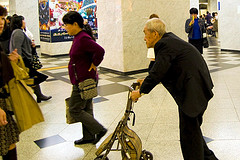 Bones are living tissue, constantly breaking down and rebuilding. They respond to the stresses placed on them, building more bone when there is more demand and breaking down when there isn’t. Weight-bearing exercise stimulates the bones to rebuild. When we are sedentary there isn’t demand to build, thus the rate of breaking down bone can go up in relation to bone-building. This is why weight-bearing exercise is important in the prevention of osteoporosis! Osteoporosis is a disease characterized by low bone mass and structural deterioration of bone tissue, leading to bone fragility. Fragile bones have an increased risk of fracture from minimal stresses. I have seen patients that have fractured their vertebrae from something as simple as getting out of bed. Osteoporosis is responsible for more than 1.5 million fractures annually, including 300,000 hip fractures, approximately 700,000 vertebral fractures, 250,000 wrist fractures, and more than 300,000 fractures at other sites. The National Osteoporosis Foundation (NOF) states, “One in two women and one in four men over the age of 50 will have an osteoporosis-related fracture in his or her remaining lifetime.” This disorder can cause real disabilities, deformities, chronic pain, and even death. There aren’t many symptoms of osteoporosis, which is why it’s called “the silent killer,” and many times it is only found after a fracture has occurred. The key to prevention is early detection, which is why I screen high-risk patients and educate them about this disease. Here is some information about this disabling and painful condition.
Bones are living tissue, constantly breaking down and rebuilding. They respond to the stresses placed on them, building more bone when there is more demand and breaking down when there isn’t. Weight-bearing exercise stimulates the bones to rebuild. When we are sedentary there isn’t demand to build, thus the rate of breaking down bone can go up in relation to bone-building. This is why weight-bearing exercise is important in the prevention of osteoporosis! Osteoporosis is a disease characterized by low bone mass and structural deterioration of bone tissue, leading to bone fragility. Fragile bones have an increased risk of fracture from minimal stresses. I have seen patients that have fractured their vertebrae from something as simple as getting out of bed. Osteoporosis is responsible for more than 1.5 million fractures annually, including 300,000 hip fractures, approximately 700,000 vertebral fractures, 250,000 wrist fractures, and more than 300,000 fractures at other sites. The National Osteoporosis Foundation (NOF) states, “One in two women and one in four men over the age of 50 will have an osteoporosis-related fracture in his or her remaining lifetime.” This disorder can cause real disabilities, deformities, chronic pain, and even death. There aren’t many symptoms of osteoporosis, which is why it’s called “the silent killer,” and many times it is only found after a fracture has occurred. The key to prevention is early detection, which is why I screen high-risk patients and educate them about this disease. Here is some information about this disabling and painful condition.
Risk Factors:
- Gender– women are at increased risk, though men get osteoporosis too!
- Increased Age
- Body Size– a thin frame
- Ethnicity– especially European and Asian
- Genetics—family history of fractures
- Low Calcium and Vitamin D intake
- Smoking
- Alcohol intake (>2 per day)
- Physical Inactivity
- Low estrogen or testosterone levels
- Certain long term medication use, including corticosteroids
- High Caffeine intake
Statistics from the NOF reports, “about 85-90% of adult bone mass is acquired by age 18 in girls and 20 in boys.” The key to maintaining good bone health is being active and getting adequate nutrition, starting at an early age. Regular weight-bearing exercise makes our bones strong, while immobility leads to diminished bone mass and weakness. Some examples of weight-bearing exercise include: walking, running, aerobics, weight training, dance, hiking, and tennis. It is important in all stages of life to maintain an active lifestyle that includes weight-bearing activities and exercise. You can stimulate bone growth by staying physically active because of Wolff’s Law.
Exercise can reduce your risk of fracture by:
- Building and maintaining bone density
- Improving balance
- Increasing flexibility
- Strengthening key muscle groups
- Correcting faulty posture that can lead to spinal fractures
If you have osteoporosis, it is important to reduce your fracture risk by not only performing weight-bearing exercise (for the lower body, upper body, and the spine), but also by working on your balance and posture in order to reduce falls. Certain postures or positions should be avoided to prevent spinal fractures, including a flexed posture. When you are “flexed” or bent over or slouched, you put more load and stress through the vertebrae. Osteoporotic bone is less likely to handle the load and stress and can fracture.
If you have been diagnosed with osteoporosis, you should avoid the following to reduce fracture risk:
- Bending forward, such as sit ups and toe touches (Make sure you logroll out of bed, never sit up!)
- Twisting at the spine
- Golf and Bowling (mainly because you are twisting in a bent over position)
- Lifting
- Poor Posture
 Nutrition and Osteoporosis
Nutrition and Osteoporosis
Research has shown that a combination of supplemental calcium and vitamin D can reduce the risk of fracture. You should consume 1200-1500mg per day of calcium and 800-1000 International Units (IU) of vitamin D per day. Calcium and vitamin D rich foods include: milk, yogurt, cheese, fortified foods or juices, almonds, green leafy vegetables such as broccoli and kale, salt-water fish, and liver. 15-20 minutes a day of sunlight exposure can also increase vitamin D production. Sodium, caffeine, and carbonated beverages increase calcium excretion, so limit the amount of these items in your diet. Excess protein increases calcium excretion, however protein is needed for fracture healing, so the key is moderation! The recommended daily intake for protein is 56 grams for men and 46 grams for women.
The best way to confront osteoporosis is through education and prevention. If you are a postmenopausal woman especially, you should ask your doctor about whether you need a bone mineral density (BMD) test. I continually educate women about osteoporosis and have identified a few people with osteopenia (pre-osteoporosis). These women were able to be counseled about exercise, diet, and the appropriate supplements to support bone health and help prevent progression to osteoporosis. The NOF states, “…in 2005, osteoporosis-related fractures were responsible for an estimated $19 billion in costs.” We can stand to save so much by preventing this disease and its consequences.
References:
Foundation for Osteoporosis Research and Education
http://www.fore.org/
“Osteoporosis and Bone Health” The Burden of Musculoskeletal Disorders in the United States. (2008).
http://www.boneandjointburden.org/
National Osteoporosis Foundation
http://www.nof.org/
NIH Osteoporosis Resource Center
http://www.niams.nih.gov/Health_Info/bone/default.asp










November 6, 2009
General Information, Geriatric, Orthopaedic, Women's Health